Calibration and Simulation Analysis of Light, Temperature, and Humidity Environmental Parameters of Sawtooth Photovoltaic Greenhouses in Tropical Areas
Abstract
:1. Introduction
2. Materials and Methods
2.1. Structural Parameters of Photovoltaic Greenhouse
2.2. Test Equipment
2.3. Test Methods
- (1)
- PAR: the PAR inside and outside the greenhouse was monitored and recorded by the environment monitoring host and the PAR sensor. The data were recorded every 30 min. Three measurement areas were selected along the diagonal of the greenhouse, located at both ends and the middle of the diagonal (see Figure 2a). In each measurement area, five points were arranged horizontally in the double-slope photovoltaic greenhouse (points ①, ②, ③, ④, and ⑤) (see Figure 2b,c), and, vertically, a test height of 30 cm was set. In the single-slope photovoltaic greenhouse, three points were arranged (points ①, ②, and ③) (see Figure 2d,e), and one point was set outside the greenhouse.
- (2)
- Temperature and humidity: the temperature and humidity inside and outside the greenhouse were continuously monitored and recorded by the environment monitoring host and the temperature–humidity transmitter. The data were collected every 30 min. Similarly to the PAR setup, three measurement areas were selected along the diagonal of the greenhouse, located at both ends and the middle of the diagonal (see Figure 2a). Considering the impact of the “edge effect”, the areas at both ends started from the second span and the second bay away from the edge. In each measurement area, six points were arranged horizontally (points A, B, C, and D, E, F) (see Figure 2b–e). Considering the height range of planting materials and human activity within the greenhouse, two vertical test heights were set: 30 cm and 180 cm, and one outside point was set on the greenhouse roof. For data analysis, full-day data were used.
2.4. Data Processing
2.4.1. Data Selection
- (1)
- PAR: When analyzing seasonal changes, the data from January to December 2022 during 8:00~18:00 were selected. When analyzing spatial distribution, the data from the same period as above were chosen. When analyzing typical weather conditions, the data from days around the summer solstice (clear on 27 June 2022, and cloudy on 10 June 2022) and the winter solstice (clear on 19 December 2022, and cloudy on 20 December 2022) during 8:00~18:00 were used.
- (2)
- Temperature and relative humidity: When analyzing seasonal changes, the data from January to December 2022 during 0:00~24:00 were selected. When analyzing spatial distribution, the data from the same period were selected. When analyzing typical weather conditions, the data from days around the summer solstice (clear on 27 June 2022, and cloudy on 10 June 2022) and the winter solstice (clear on 19 December 2022, and cloudy on 20 December 2022) during 0:00~24:00 were used.
2.4.2. Methods and Software
- (1)
- Data Analysis:
- (2)
- Software:
3. Results and Analyses
3.1. Analysis of Photosynthetically Active Radiation (PAR)
3.1.1. Seasonal Changes in PAR
3.1.2. Spatial Distribution of PAR
3.1.3. Diurnal Changes in PAR Under Typical Weather
3.2. Change Laws of Temperature
3.2.1. Seasonal Changes in Temperature
3.2.2. Spatial Distribution of Temperature
3.2.3. Diurnal Changes in Temperature Under Typical Weather
3.3. Change Laws of Relative Humidity
3.3.1. Seasonal Changes in Relative Humidity
3.3.2. Spatial Distribution of Relative Humidity
3.3.3. Diurnal Changes in Relative Humidity Under Typical Weather
3.4. Simulation Analysis of PAR and Light Transmittance
Modeling and Parameter Setting of Photovoltaic Greenhouses
- (1)
- Modeling of photovoltaic greenhouses
- (2)
- Parameter setting of photovoltaic greenhouse models
4. Discussions
- (1)
- PAR: The average PAR levels in the double-slope photovoltaic greenhouse across the four seasons were 190.97 μmol/(m2·s), 269.69 μmol/(m2·s), 122.79 μmol/(m2·s), and 76.47 μmol/(m2·s), respectively. In the single-slope photovoltaic greenhouse, the average PAR levels for the four seasons were 173.62 μmol/(m2·s), 170.53 μmol/(m2·s), 101.45 μmol/(m2·s), and 64.77 μmol/(m2·s), respectively. According to the photosynthetic saturation point and light compensation point of crops, both types of photovoltaic greenhouses were suitable for growing shade-tolerant leafy vegetables such as water spinach, pak choi, bok choy, and Chinese mustard.
- (2)
- Light transmittance: The annual average light transmittance of the double-slope photovoltaic greenhouse and the single-slope photovoltaic greenhouse were 23.91% and 19.17%, respectively. The roof angle of both types of photovoltaic greenhouses was 15°. According to the range of solar elevation angles in Hainan throughout the year (47~90°), the range of incident angles of the two types of photovoltaic greenhouses could be calculated to be 15~38°. When the incident angle was 0°, the reflectance would be 0, and the transmittance would reach the maximum of 90%. The decrease in light transmittance was not significant when the incident angle was smaller than 40°. Therefore, the solar elevation angle had little impact on the two types of photovoltaic greenhouses in this experiment. The comparison between simulated results and measured results also showed that the simulated values had similar trends to measured values, but the simulated values were relatively higher. The analysis of the local climatic conditions showed that summer and autumn were rainy seasons in Hainan, whereas winter and spring were dry seasons. Frequent rain during summer and autumn could enhance the growth of moss on the roof’s light-transmitting materials, thereby reducing the light transmittance to some extent. Therefore, the transmittance coefficient of the light-transmitting cover materials should be adjusted according to the actual conditions when setting up the model.
- (3)
- Temperature: The indoor temperatures of both types of serrated photovoltaic greenhouses were higher than that outdoors, with the largest difference occurring in summer when temperatures were high, and the smallest difference in winter when temperatures were low. The average summer temperatures of the two types of greenhouses were 30.91 °C and 30.09 °C, respectively, while the average winter temperatures were 18.94 °C and 18.88 °C, respectively. According to the temperature requirements for crop growth, the two types of serrated photovoltaic greenhouses were suitable for growing heat-tolerant leafy vegetables [29]. Vertically, the temperature in the double-slope photovoltaic greenhouse generally decreased with an increase in height. This was because the ridge of the double-slope greenhouse was covered with insect-proof screens, which could facilitate natural ventilation (due to wind pressure and thermal buoyancy) and enhance air circulation with the outside, leading to lower temperatures at higher levels. Therefore, the temperatures were slightly lower at higher elevations compared with lower ones. In contrast, single-slope photovoltaic greenhouse had reverse results. This was because the space between the PV panels and the glass panels on the roof were sealed with aluminum foil butyl tape and the ventilation openings were on one side, resulting in less vertical temperature difference compared with the double-slope greenhouse.
- (4)
- Relative humidity: In this experiment, the average indoor relative humidity levels in both types of serrated photovoltaic greenhouses both ranged from approximately 80 to 90% across all seasons, with a fairly uniform spatial distribution. The suitable relative humidity to grow leafy vegetables, which were tolerant to high humidity, was 85–90% [30]. Therefore, these two types of serrated photovoltaic greenhouses are quite suitable for the cultivation and year-round production of leafy vegetables.
5. Conclusions
- (1)
- The annual average PAR for the double-slope and single-slope photovoltaic greenhouses was 164.98 μmol/(m2·s) and 127.59 μmol/(m2·s) respectively, with a light transmittance of 23.91% and 19.17%. Under the same coverage rate (57%), the average light transmittance of the double-slope greenhouse was 4.74% higher and the average annual PAR was 37.39 μmol/(m²·s) higher than the single-slope greenhouse.
- (2)
- The annual average temperatures in the double-slope and single-slope photovoltaic greenhouses were 25.56 °C and 25.10 °C, respectively, with the double-slope greenhouse having an indoor temperature 0.46 °C higher than the single-slope.
- (3)
- The annual average relative humidity levels in the double-slope and single-slope photovoltaic greenhouses were 85.00% and 86.88%, respectively, and the indoor relative humidity of the double-slope greenhouse was a bit lower than the single-slope, with a difference of 1.88%.
- (4)
- The light transmittance in both types of greenhouses was simulated using Design Builder software. The results show that the simulated values were generally consistent with the measured values and were overall higher than the measured values, with an average difference within 5%.
Author Contributions
Funding
Data Availability Statement
Acknowledgments
Conflicts of Interest
Nomenclature
| PV | Photovoltaic |
| DLI | Daily Light Integral |
| PAR | Photosynthetically active radiation |
References
- Djevic, M.; Dimitrijevic, A. Energy consumption for different greenhouse constructions. Energy 2009, 34, 1325–1331. [Google Scholar]
- Al-Ibrahim, A.; Al-Abbadi, N.; Al-Helal, I. Photovoltaic greenhouse system, system description, performance and lesson learned. Acta Hortic. 2006, 710, 251–264. [Google Scholar]
- Al-Shamiry, F.; Ahmad, D.; Sharif, A.R.M.; Aris, I.; Janius, R.; Kamaruddin, R. Design and development of photovoltaic power system for tropical greenhouse cooling. Am. J. Appl. Sci. 2018, 4, 386–389. [Google Scholar]
- Sonneveld, P.J.; Swinkels, G.L.A.M.; Campen, J.; van Tuijl, B.A.J.; Janssen, H.J.J.; Bot, G.P.A. Performance results of a solar greenhouse combining electrical and thermal energy production. Biosyst. Eng. 2010, 106, 48–57. [Google Scholar]
- Yano, A.; Onoe, M.; Nakata, J. Prototype semi-transparent photovoltaic modules for greenhouse roof applications. Biosyst. Eng. 2014, 122, 62–73. [Google Scholar]
- Trypanagnostopoulos, G.; Kavga, A.; Souliotis, M.; Tripanagnostopoulos, Y. Greenhouse performance results for roof installed photovoltaics. Renew. Energy 2017, 111, 724–731. [Google Scholar]
- Yano, A.; Kadowaki, M.; Furue, A.; Tamaki, N.; Tanaka, T.; Hiraki, E.; Kato, Y.; Ishizu, F.; Noda, S. Shading and electrical features of a photovoltaic array mounted inside the roof of an east-west oriented greenhouse. Biosyst. Eng. 2010, 106, 367–377. [Google Scholar]
- Kadowaki, M.; Yano, A.; Ishizu, F.; Tanaka, T.; Noda, S. Effects of greenhouse photovoltaic array shading on Welsh onion growth. Biosyst. Eng. 2011, 111, 290–297. [Google Scholar]
- Ezzaeri, K.; Fatnassi, H.; Wifaya, A.; Bazgaou, A.; Aharoune, A.; Poncet, C.; Bekkaoui, A.; Bouirden, L. Performance of photovoltaic canarian greenhouse: A comparison study between summer and winter seasons. Sol. Energy 2020, 198, 275–282. [Google Scholar]
- Fatnassi, H.; Poncet, C.; Brun, R.; Muller, M.M.; Bertin, N. CFD Study of Climate Conditions under Greenhouses Equipped with Photovoltaic Panels. Acta Hortic. 2014, 1054, 63–72. [Google Scholar]
- Worku, W.; Skjelvåg, A.; Gislerød, H. Responses of common bean (Phaseolus vulgaris L.) to photosynthetic irradiance levels during three phenological phases. Agronomie 2004, 24, 267–274. [Google Scholar]
- Moretti, S.; Marucci, A. A photovoltaic greenhouse with variable shading for the optimization of agricultural and energy production. Energies 2019, 12, 2589. [Google Scholar] [CrossRef]
- Fu, J.; Li, C.-H.; Zhao, J.-R.; Ma, L.; Liu, T.-X. Shade-tolerance indices of maize: Selection and evaluation. Chin. J. Appl. Ecol. 2009, 20, 2705. [Google Scholar]
- Tani, A.; Shiina, S.; Nakashima, K.; Hayashi, M. Improvement in lettuce growth by light diffusion under solar panels. J. Agric. Meteorol. 2014, 70, 139–149. [Google Scholar]
- Cossu, M.; Yano, A.; Solinas, S.; Deligios, P.A.; Tiloca, M.T.; Cossu, A.; Ledda, L. Agricultural sustain ability estimation of the European photovoltaic greenhouses. Eur. J. Agron. 2020, 118, 126074. [Google Scholar]
- Ezzaeri, K.; Fatnassi, H.; Bouharroud, R.; Gourdo, L.; Bazgaou, A.; Wifaya, A.; Demrati, H.; Bekkaoui, A.; Aharoune, A.; Poncet, C.; et al. The effect of photovoltaic panels on the microclimate and on the tomato production under photovoltaic canarian greenhouses. Solar Energy 2018, 173, 1126–1134. [Google Scholar]
- Aroca-Delgado, R.; Pérez-Alonso, J.; Callejón-Ferre, Á.-J.; Díaz-Pérez, M. Morphology, yield and quality of greenhouse tomato cultivation with flexible photovoltaic rooftop panels. Sci. Hortic. 2019, 257, 108768. [Google Scholar]
- López-Díaz, G.; Carreño-Ortega, A.; Fatnassi, H.; Ponce, C.; Díaz-Pérez, M. The Effect of Different Levels of Shading in a Photovoltaic Greenhouse with a North–South Orientation. Appl. Sci. 2020, 10, 882. [Google Scholar] [CrossRef]
- Cossu, M.; Murgia, L.; Ledda, L.; Deligios, P.A.; Sirigu, A.; Chessa, F.; Pazzona, A. Solar radiation distribution inside a greenhouse with south-oriented photovoltaic roofs and effects on crop productivity. Appl. Energy 2014, 133, 89–100. [Google Scholar]
- Hassanien, R.H.E.; Ming, L. Influences of greenhouse-integrated semitransparent photovoltaics on microclimate and lettuce growth. Int. J. Agric. Biol. Eng. 2017, 10, 11–22. [Google Scholar]
- Hsiao, C.-L.; Wang, C.-Y.; Hsu, Y.-T. Effect of Simulated Photovoltaic Roofs on the Yield and Nitrate Content of Pak Choi and Rape. HortScience 2023, 58, 1297–1305. [Google Scholar] [CrossRef]
- Wei, D.; Zengchan, Z.; Wenxi, L.; Fengmei, T.; Shuili, L.; Jian, Z. Comparison of indoor and outdoor environmental conditions of photovoltaic greenhouse. Agric. Eng. 2015, 5, 44–48. [Google Scholar]
- Liu, J.; Chen, Y.; Wang, B.; Wu, X.; Na, Y. Simulation and experimental study of light and thermal environment of photovoltaic greenhouse in tropical area based on design builder. Appl. Sci. 2021, 11, 10785. [Google Scholar] [CrossRef]
- Amara, H.B.; Bouadila, S.; Fatnassi, H.; Arici, M.; Guizani, A.A. Climate Assessment of greenhouse equipped with south-oriented PV roofs: An experimental and computational fluid dynamics study. Sustain. Energy Technol. Assess. 2021, 45, 101100. [Google Scholar]
- Somov, A.; Shadrin, D.; Fastovets, I.; Nikitin, A.; Matveev, S.; Seledets, I.; Hrinchuk, O. Pervasive Agriculture: IoT-Enabled Greenhouse for Plant Growth Control. IEEE Pervasive Comput. 2018, 17, 65–75. [Google Scholar] [CrossRef]
- Wang, J.; Yang, D. Research progress on control methods of greenhouse environment. J. Chin. Agric. Mech. 2018, 39, 49–53. [Google Scholar] [CrossRef]
- Walczuch, D.; Nitzsche, T.; Seidel, T.; Schoning, J. Overview of Closed-Loop Control Systems and Artificial Intelligence Utilization in Greenhouse Farming. In Proceedings of the IEEE International Conference on Omni-Layer Intelligent Systems (COINS), Barcelona, Spain, 18 August 2022; pp. 1–6. [Google Scholar]
- Sun, W.; Kong, F.T.; Zhang, J.H.; Wu, J.Z.; Chai, X.; Cao, S.S. Greenhouse Intelligent Control System Based on Indoor and Outdoor Environmental Data Fusion. Earth Environ. Sci. 2020, 440, 042073. [Google Scholar] [CrossRef]
- Yang, L.; Chen, D. Analysis of light transmittance of different covering materials in solar greenhouse. Shaanxi J. Agric. Sci. 2018, 64, 29–31. [Google Scholar]
- Zou, Z.-R.; Shao, X.-H. Environmental Engineering of Facility Agriculture; China Agriculture Press: Beijing, China, 2008; pp. 54–55. [Google Scholar]
- Moreno, Á.; Chemisana, D.; Lamnatou, C.; Maestro, S. Energy and photosynthetic performance investigation of a semitransparent photovoltaic rooftop greenhouse for building integration. Renew. Energy 2023, 215, 118976. [Google Scholar] [CrossRef]
- Yu, Y. Cooling Effect and Evaluation of Greenhouse with Full Roof Window in Summer. Master’s Thesis, Shanghai Jiao Tong University, Shainghai, China, 2008; pp. 10–14. [Google Scholar]

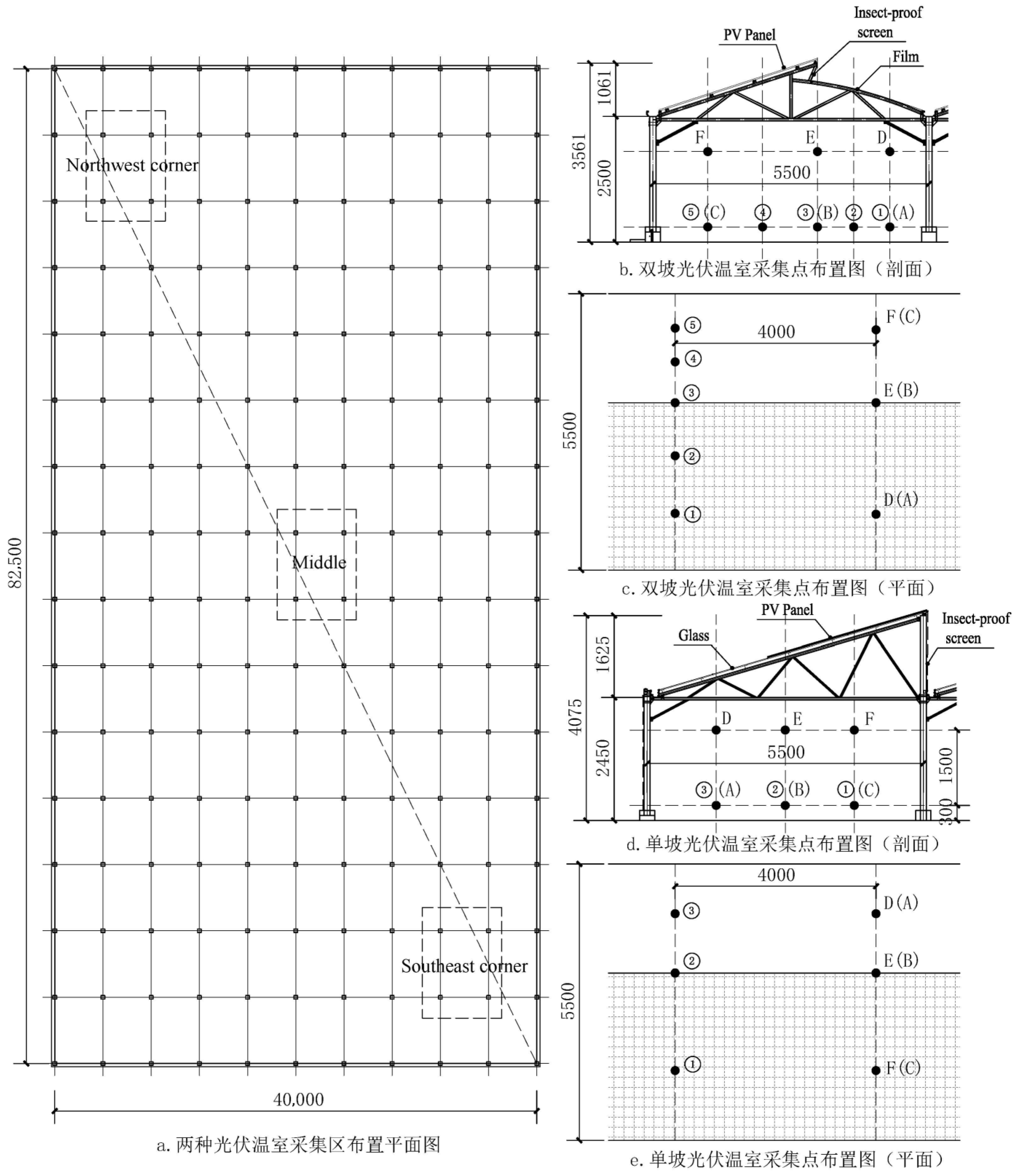

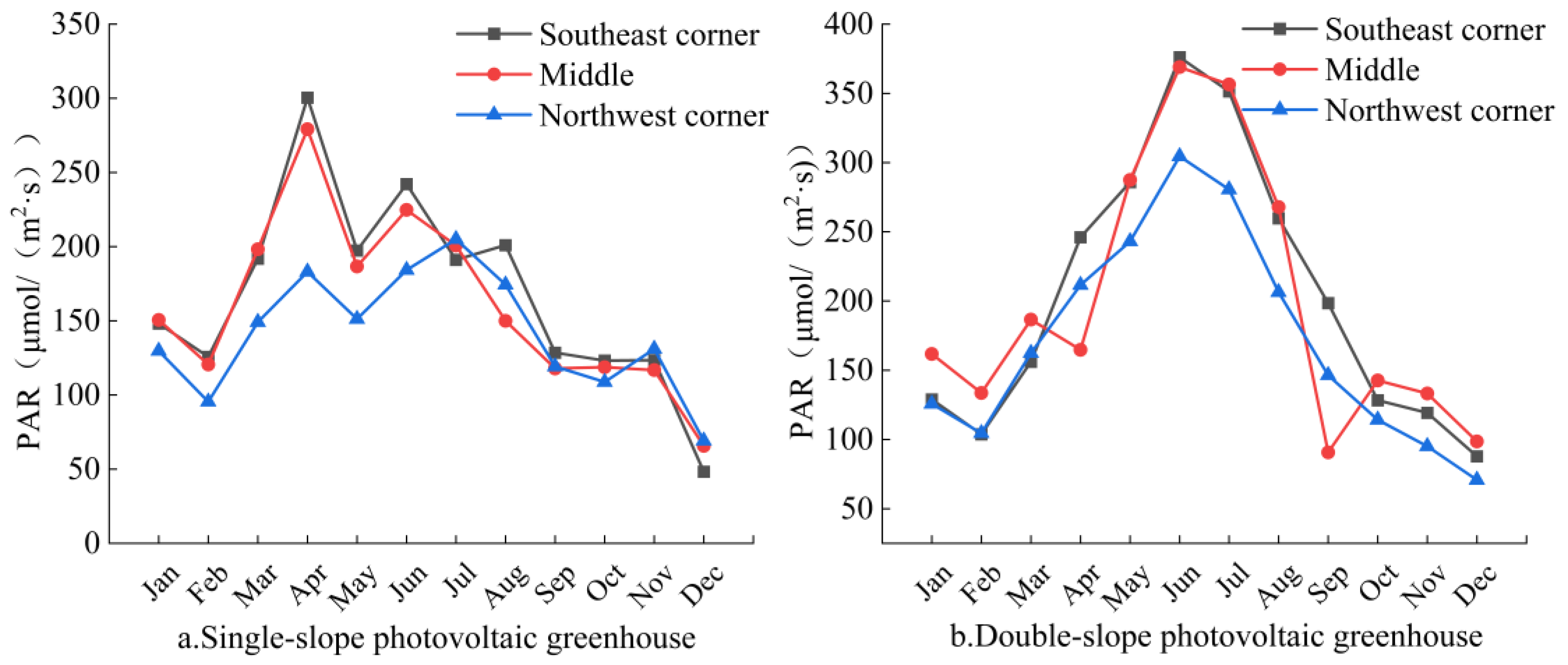
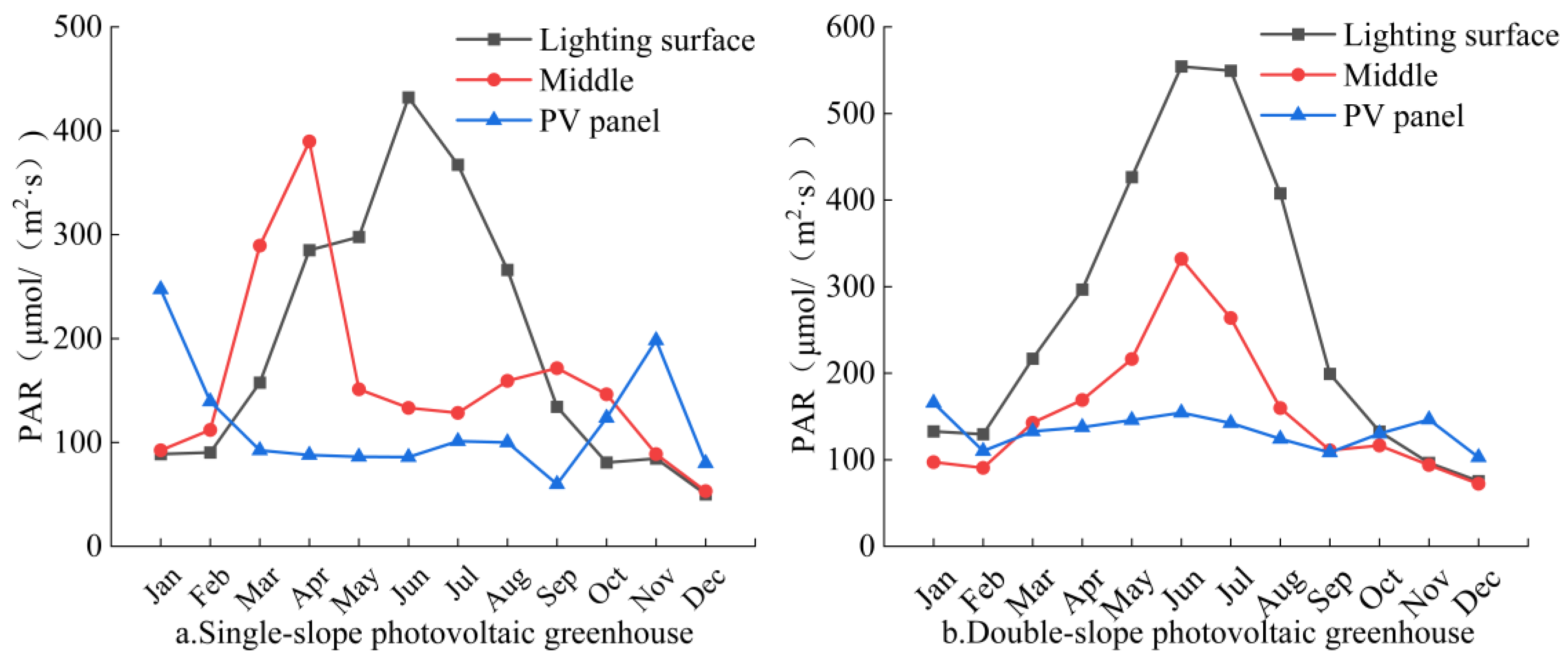
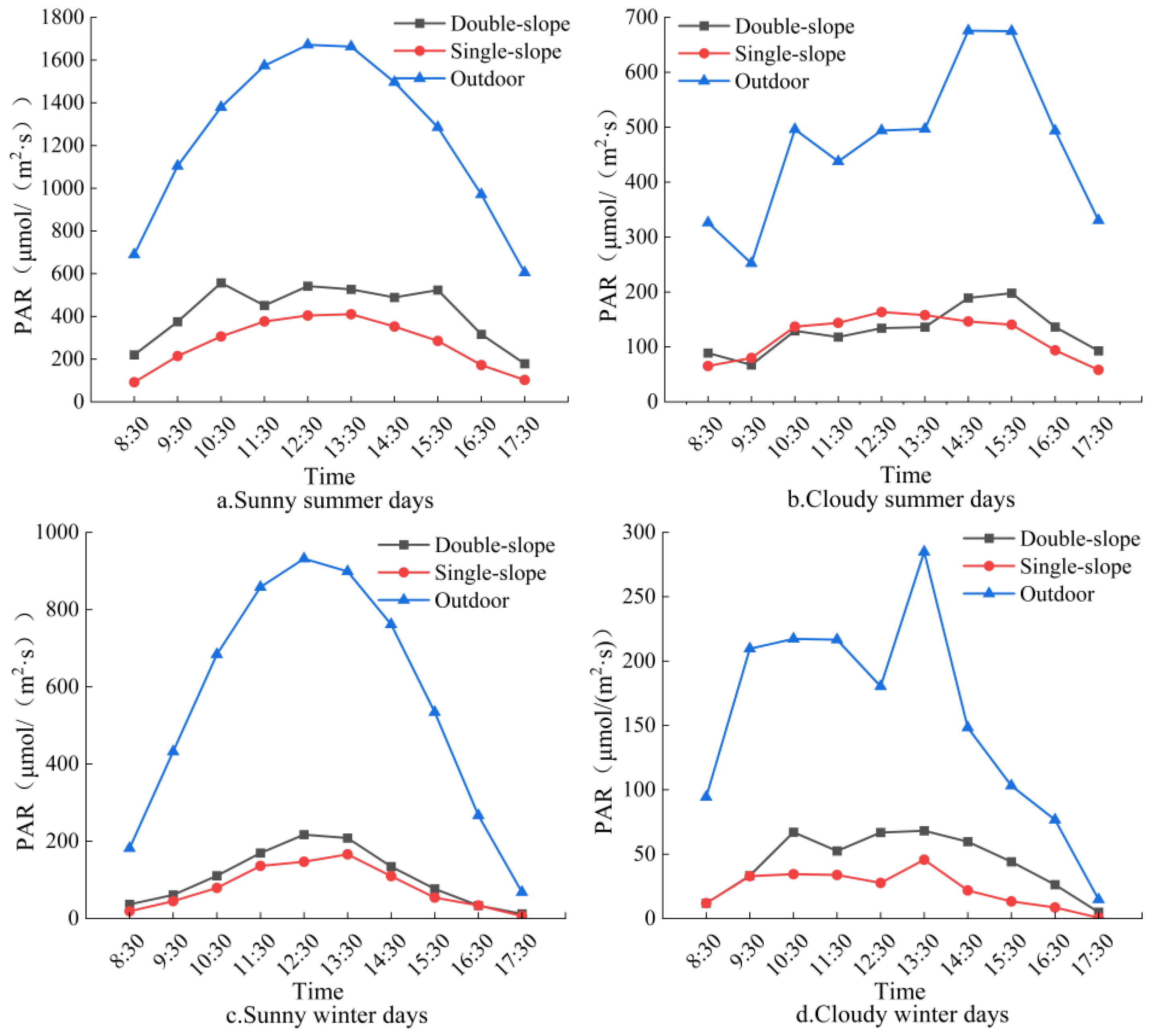


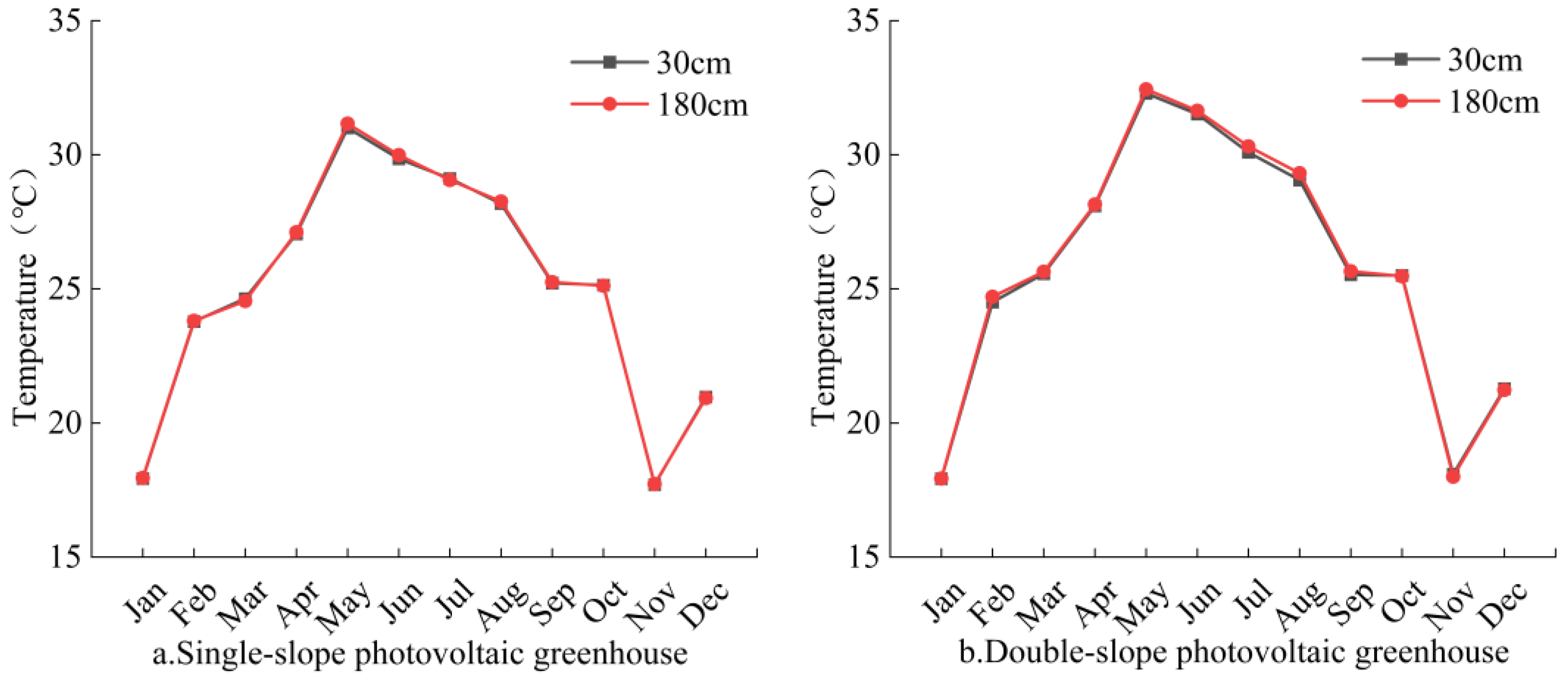
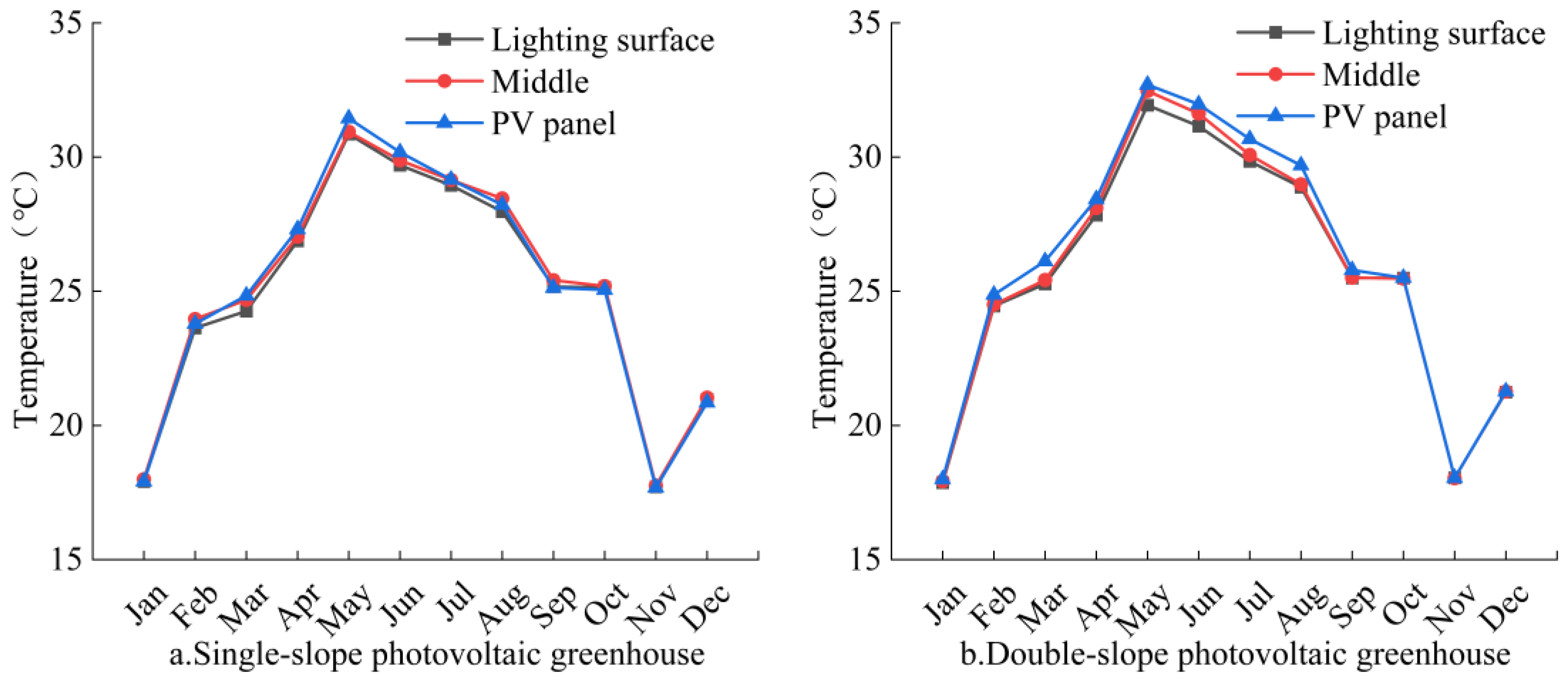
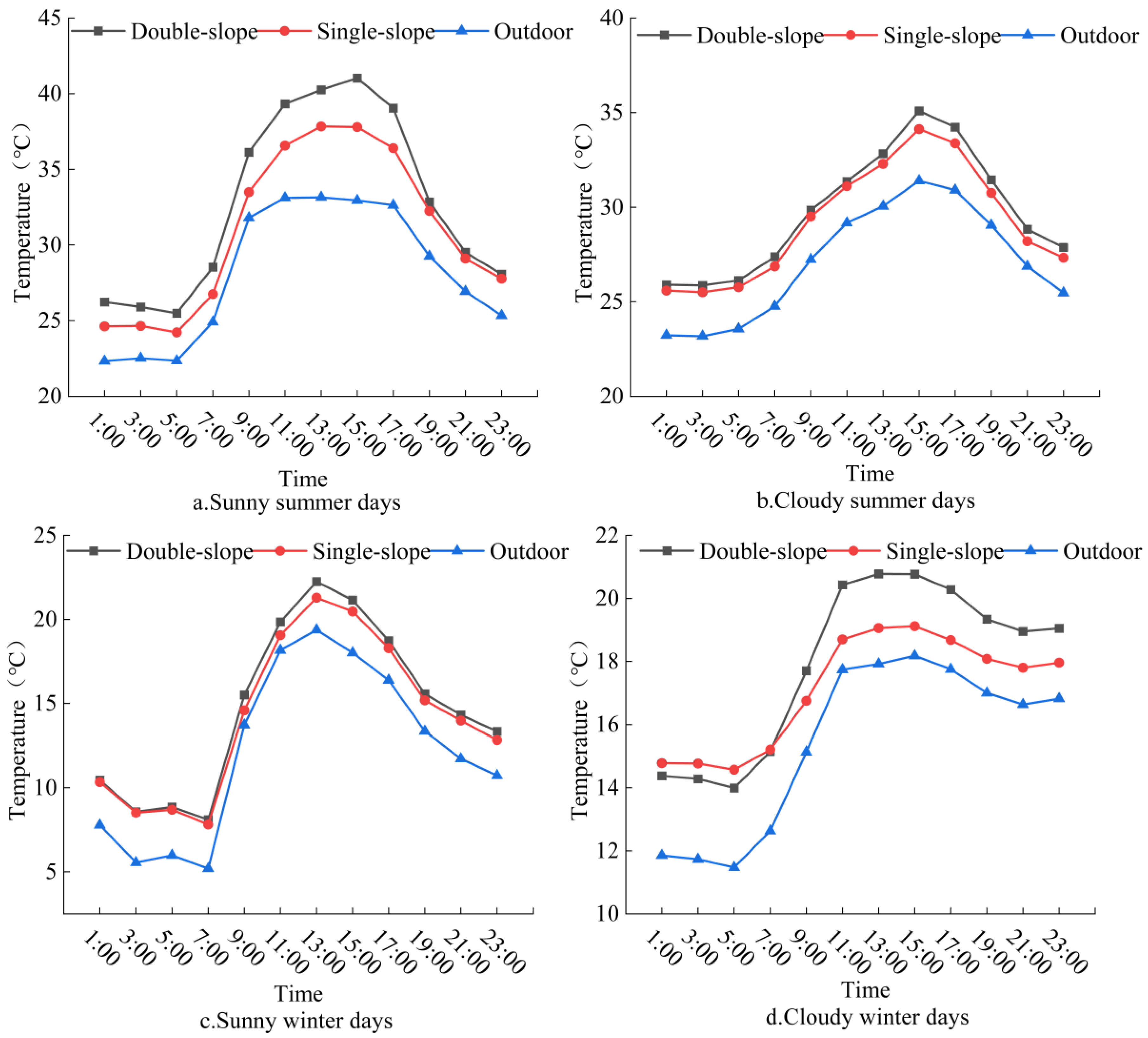

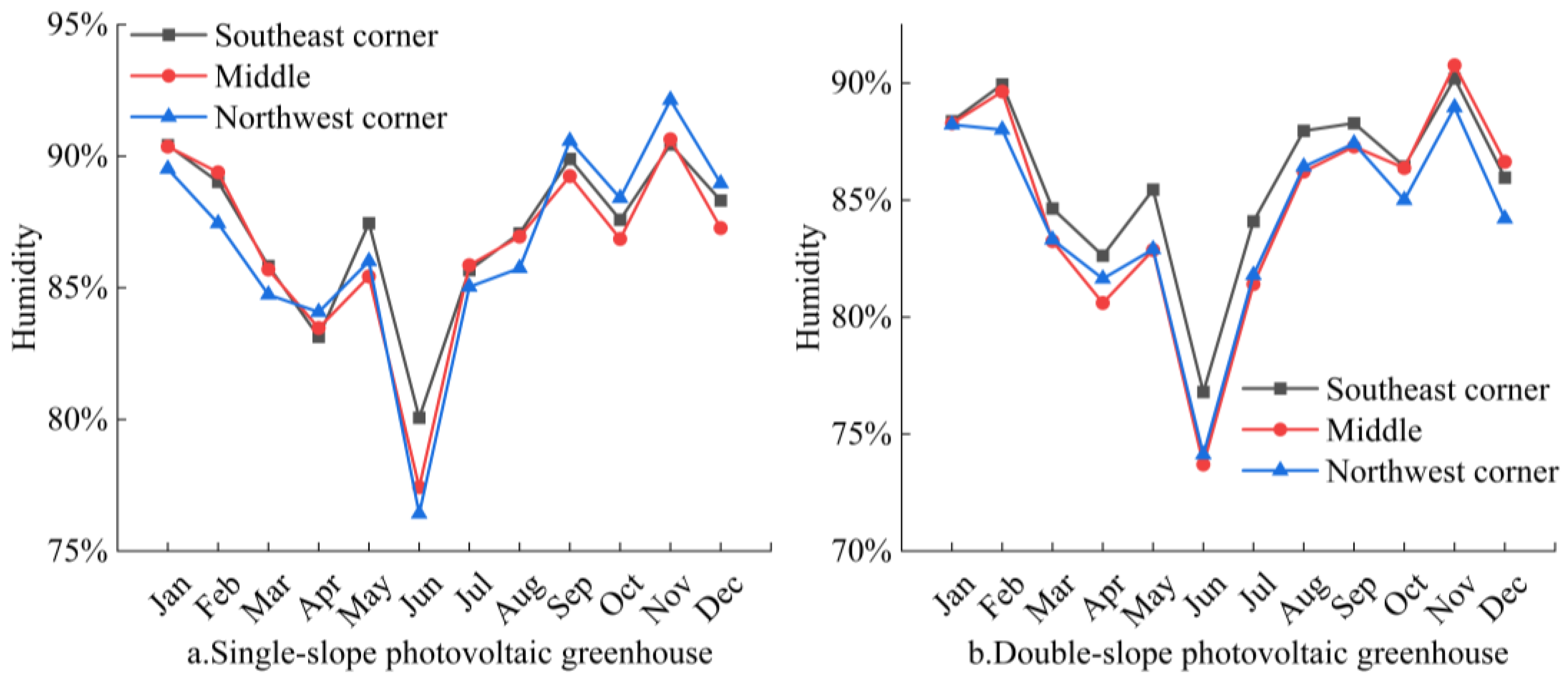

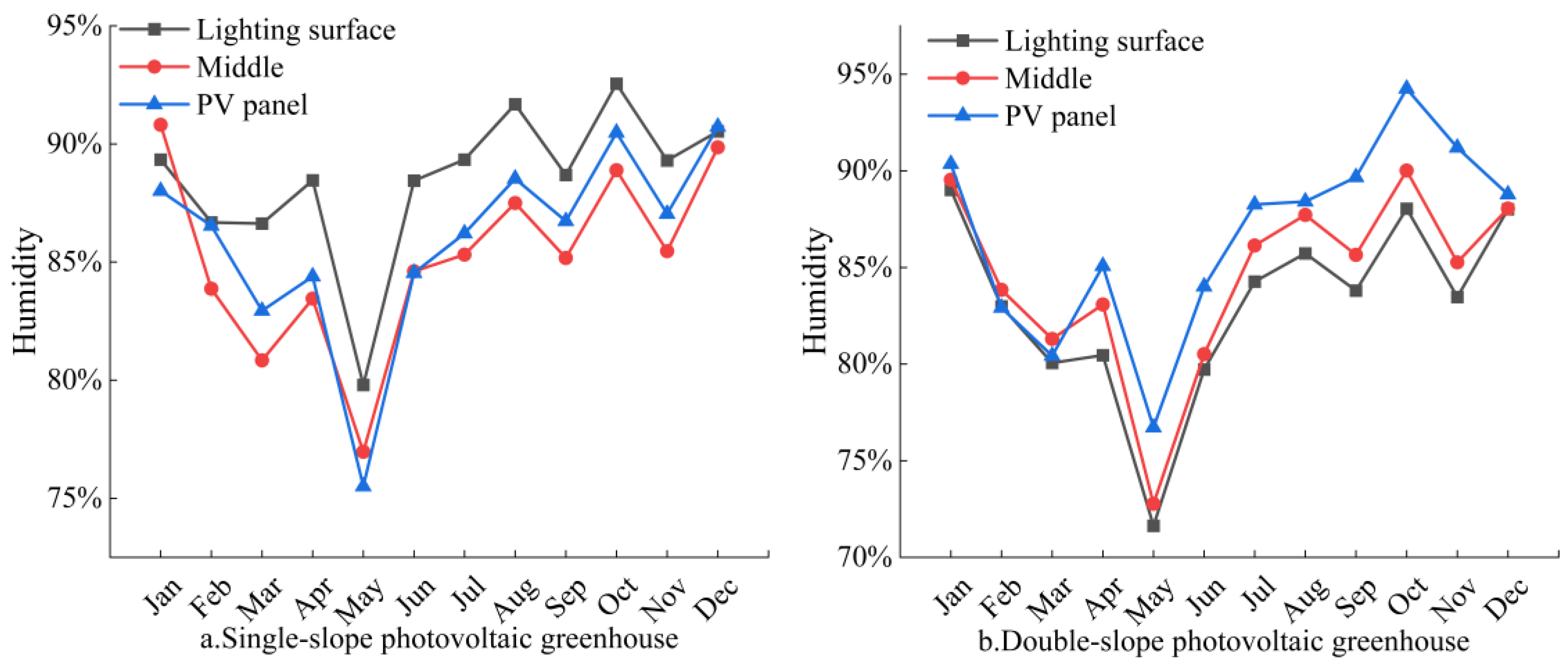

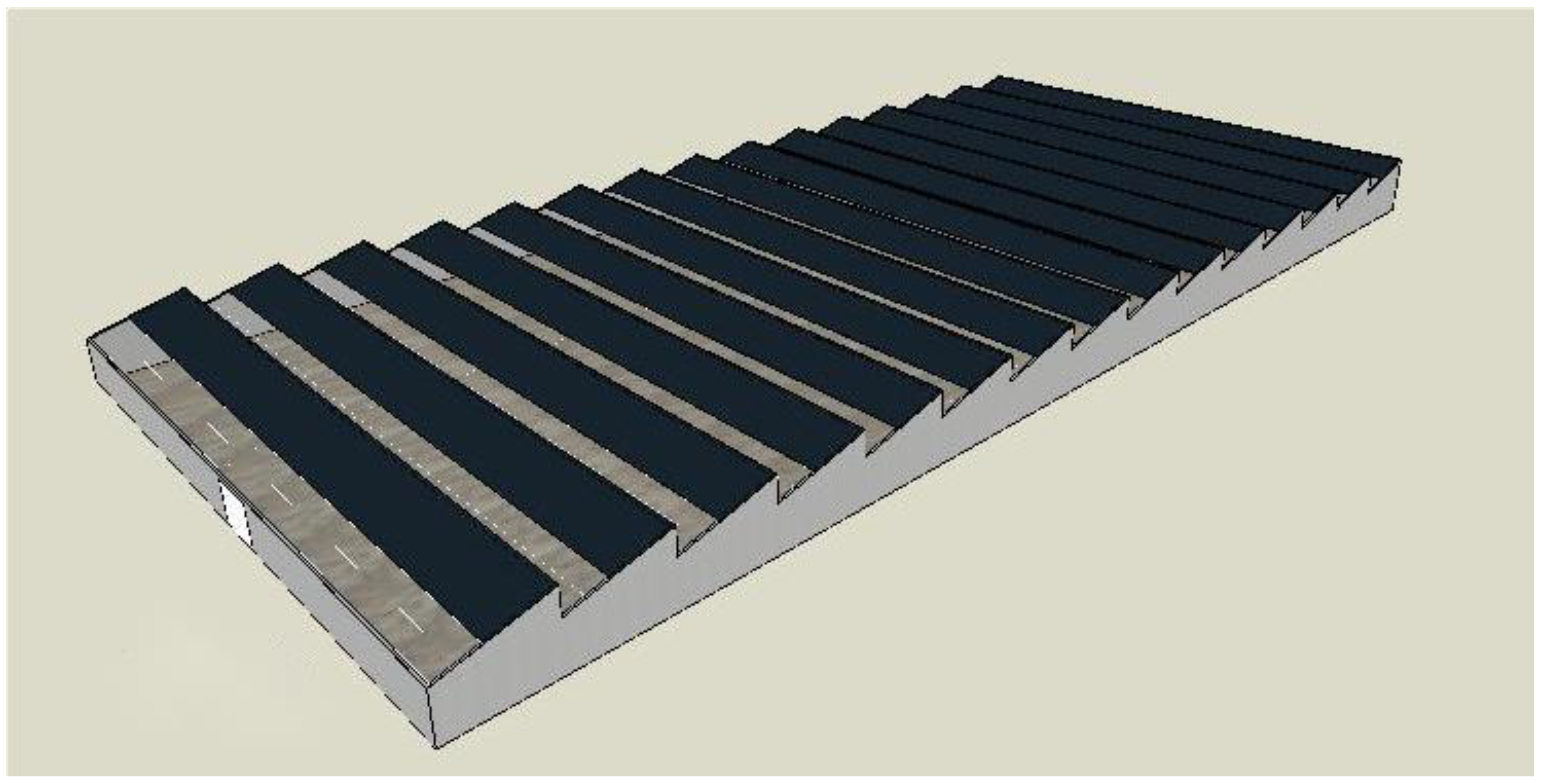
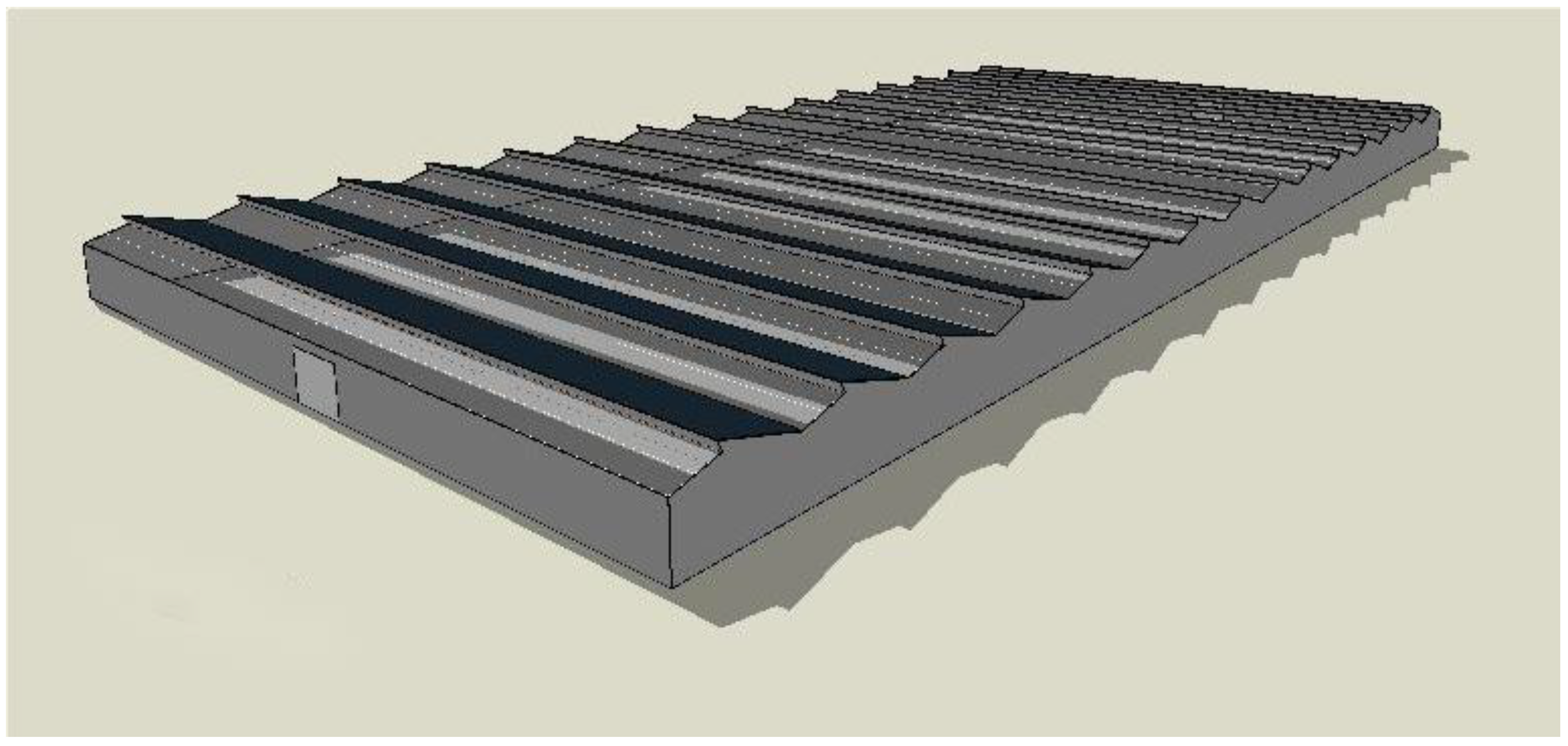

| Double-Slope Photovoltaic Greenhouse | Single-Slope Photovoltaic Greenhouse | Outdoor | |
|---|---|---|---|
| PAR (μmol/(m2·s)) | 164.98 | 127.59 | 658.69 |
| Illuminance (Lux) | 8908.98 | 6890.06 | 35,569.04 |
| Light transmittance (%) | 23.91 | 19.17 |
| Types | Double-Slope Temperature | Single-Slope Temperature | Outdoor |
|---|---|---|---|
| Day temperature (°C) | 28.01 | 27.22 | 24.51 |
| Night temperature (°C) | 23.12 | 22.98 | 20.60 |
| Average temperature (°C) | 25.56 | 25.10 | 22.55 |
| Components | Materials | Parameters |
|---|---|---|
| Covering materials | PV panels | Light transmittance 10%, thermal conductivity 0.76 W/(m·K) |
| Film Glass | Light transmittance 80%, thermal conductivity 0.17 W/(m·K) Light transmittance 85%, thermal conductivity 0.76 W/(m·K) | |
| 40-mesh insect-proof screen | Light transmittance 76.5%, porosity 53.76% | |
| Ground of greenhouse | Soil | Thermal conductivity 3.5 W/(m·K), specific heat 1.046 J/(kg·°C) |
Disclaimer/Publisher’s Note: The statements, opinions and data contained in all publications are solely those of the individual author(s) and contributor(s) and not of MDPI and/or the editor(s). MDPI and/or the editor(s) disclaim responsibility for any injury to people or property resulting from any ideas, methods, instructions or products referred to in the content. |
© 2025 by the authors. Licensee MDPI, Basel, Switzerland. This article is an open access article distributed under the terms and conditions of the Creative Commons Attribution (CC BY) license (https://creativecommons.org/licenses/by/4.0/).
Share and Cite
Liu, J.; Wu, Q.; Chen, Y.; Shi, Y.; Wang, B. Calibration and Simulation Analysis of Light, Temperature, and Humidity Environmental Parameters of Sawtooth Photovoltaic Greenhouses in Tropical Areas. Agronomy 2025, 15, 857. https://doi.org/10.3390/agronomy15040857
Liu J, Wu Q, Chen Y, Shi Y, Wang B. Calibration and Simulation Analysis of Light, Temperature, and Humidity Environmental Parameters of Sawtooth Photovoltaic Greenhouses in Tropical Areas. Agronomy. 2025; 15(4):857. https://doi.org/10.3390/agronomy15040857
Chicago/Turabian StyleLiu, Jian, Qingsen Wu, Yini Chen, Yijie Shi, and Baolong Wang. 2025. "Calibration and Simulation Analysis of Light, Temperature, and Humidity Environmental Parameters of Sawtooth Photovoltaic Greenhouses in Tropical Areas" Agronomy 15, no. 4: 857. https://doi.org/10.3390/agronomy15040857
APA StyleLiu, J., Wu, Q., Chen, Y., Shi, Y., & Wang, B. (2025). Calibration and Simulation Analysis of Light, Temperature, and Humidity Environmental Parameters of Sawtooth Photovoltaic Greenhouses in Tropical Areas. Agronomy, 15(4), 857. https://doi.org/10.3390/agronomy15040857






